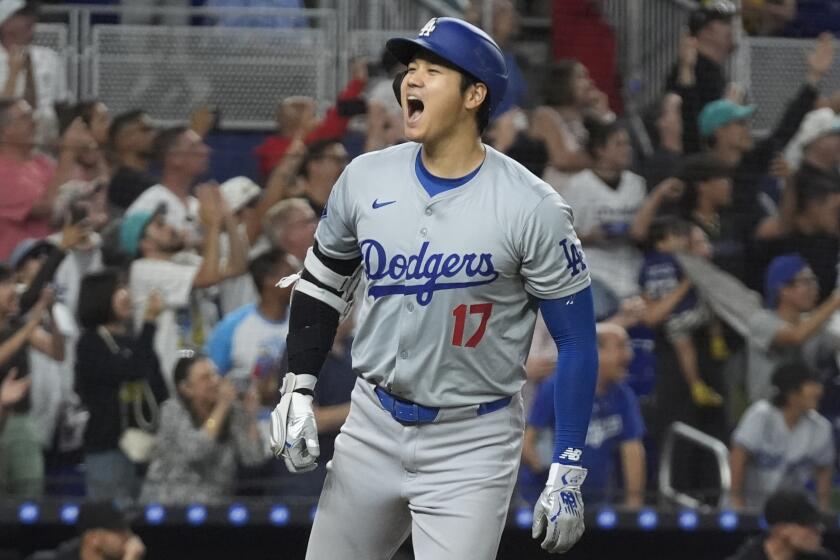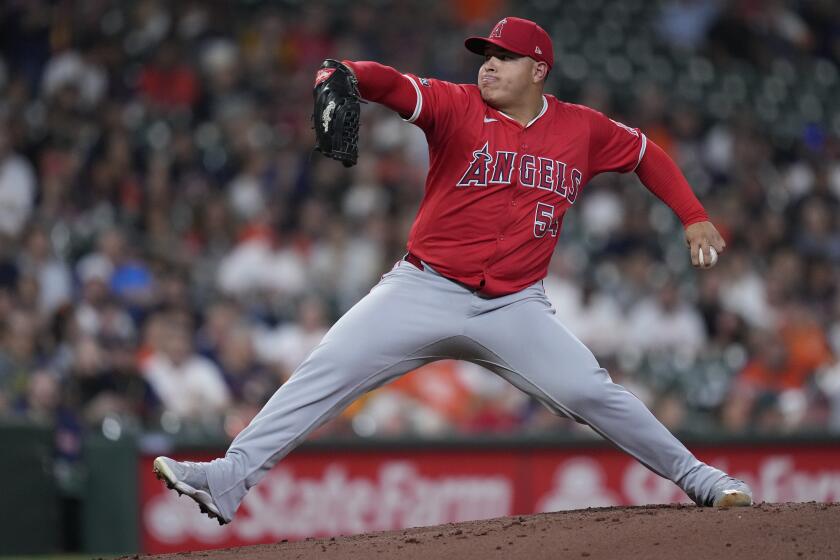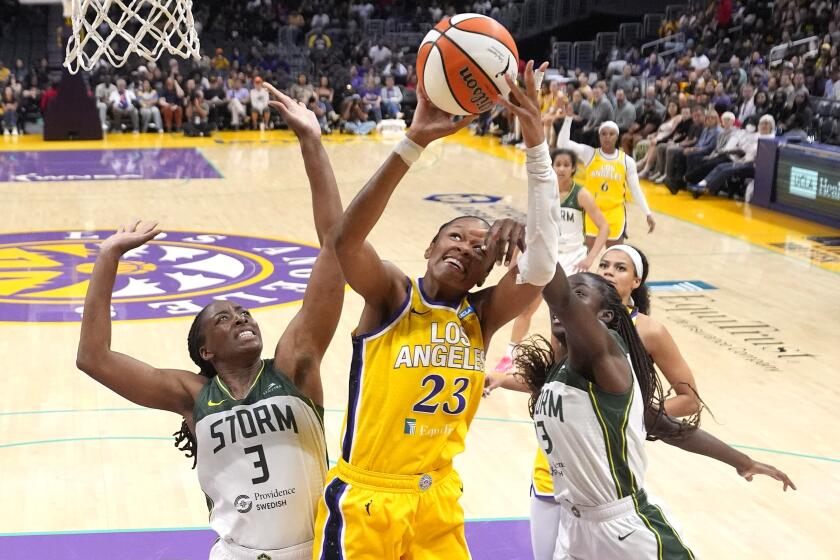Is sumo more act than action?
It sure looks real enough, all those vicious slaps to the face and head-smacking collisions and men of generous poundage being hurled into the dirt.
But the shadow of fraud hangs over this spring’s sumo tournament in Osaka. The event is taking place in the wake of a muckraking weekly magazine’s accusations that Japan’s national sport is all scripted, and allegations that a stunning run of tournament victories by Asashoryu, the unassailable grand champion who hails from Mongolia, has been greased by bribes.
Could it be that these goliaths will take a tumble for a price? Has Asashoryu’s supremacy really been built on cash distribution rather than his speed, brute power and nasty streak?
Nah, say most of those filling the seats here at the Osaka Gymnasium during the sumo world’s annual sojourn outside Tokyo, which began Sunday. They won’t accept that the sport might be fixed. And even if Asa, as he is nicknamed, has paid off other wrestlers, they say it won’t ruin their enjoyment of a pageant that depends in large part on artistic showmanship.
“If they were amateur athletes, I wouldn’t be able to forgive fixing,” said Yoshihide Shiramizu, 47, a former amateur sumo wrestler who claims he can tell when competitors are holding back, which he acknowledges they might sometimes do, if only to avoid injury. “Of course money is a key factor for professionals. But it doesn’t mean they win or lose for it.”
The sumo world is now facing the question of whether artistic showmanship has evolved into an artistic license to cheat. The trouble began about a month ago when the magazine Shukan Gendai reported that it had sources spilling secrets from behind sumo’s opaque curtain.
Reporter Yorimasa Takeda said he became suspicious about how Asashoryu kept winning tournaments without appearing to train very hard: 20 and counting, a number surpassed by only five wrestlers in recorded sumo history.
How, he asked, could Asashoryu lose so rarely when he was spending most of his time back in Mongolia, running businesses?
“He shows up here only to earn money and leaves scars on the sport,” Takeda complained in an interview.
In publishing its allegations that Asashoryu was paying off other wrestlers, Takeda’s magazine named names, citing a cabal of Asashoryu’s fellow Mongolians and other foreign wrestlers who have arrived in recent years to put a cosmopolitan stamp on the top level of Japan’s homespun sport.
But the magazine also named Japanese wrestlers, asserting that a handful of “clean” wrestlers were being cowed into silence by the sport’s governing body’s anxiety to avoid a scandal that could threaten its tax-free status.
Aggrieved wrestlers angrily denied the charges. And the sumo association responded with a swift investigation, pronounced itself clean and promptly sued the magazine for $4 million.
Most observers seem to think there will be an out-of-court settlement once the spotlight dims. Even Takeda doesn’t give his magazine much of a chance in court unless he’s able to persuade his sources to testify.
But he stands by his assertion that sumo is founded upon a system in which prize money accrues to a wealthy few top athletes and that as a result, the sport has always had an informal system of “redistributing” money to keep lower-ranked wrestlers happy and the industry alive.
That depiction is seconded by Keisuke Itai, a professional sumo wrestler in the 1980s who said in an interview that he spent his career throwing matches for money against some of the most famous fighters in the business.
“Even the best wrestlers want some insurance against losing,” Itai said. “The fixing used to be much worse than it is now. But I can tell by watching that they are still doing it.”
With the wrestlers under greater scrutiny, Osaka’s spring tournament has taken on heightened significance. Many are on the lookout for signs of choreography. And it would be interesting to see the results with every wrestler fighting for keeps, although most observers expected Asashoryu’s speed, strength and aggression to see him through.
Then Asashoryu went out and lost his first Osaka match, in humiliating style.
“Asa Loses! Why?” blared the headline in the Nikkan Gendai, an evening tabloid, over pictures of an embarrassed Asashoryu in the grip of an opponent who had wrapped him up from behind and was marching him out of the ring.
Hmm.
Still, the Osaka Gymnasium was hardly the place to find skeptics Monday on Day 2 of the 15-day tournament.
“I don’t think there’s fixing,” Noriaki Tokuchi, 60, president of a manufacturing company, said as he watched the action. Then he softened a bit.
“If they did serious fixing, it would be bad,” he said. “But it’s a matter of degree. If they do fix, it’s within an accepted range.”
There was nothing in the spectators’ behavior to suggest they felt duped, or that they were ready to see sumo lumped with the acting hams of World Wrestling Entertainment. Nothing to match the abuse that American crowds hurl at baseball’s Barry Bonds, allegedly a onetime user of steroids.
There has been no dissing of the sumo wrestlers in Osaka. No cries of “Fix!” coming down from the (relatively) cheap seats in a venue where decent seats cost more than $100. No wide-eyed kids imploring, “Say it ain’t so, Asa.”
Instead, when the wrestlers entered the arena, teenage girls still squealed and snapped pictures with their cellphone cameras.
The regulars still settled onto mats around the ring with their boxed lunches, and the tourists still paid the hefty ticket prices to get a taste of Old Japan.
Then it was all eyes on Asashoryu for the last match of the day. His opponent was the massive Japanese wrestler Miyabiyama, at 29 struggling to earn his way back into sumo’s upper ranks.
“I just wanted to keep him at bay,” Miyabiyama said later.
Instead, he rocked Asashoryu’s world. The two wrestlers slammed away at each other until Miyabiyama staggered the grand champion with a straight arm and, to ecstatic cheers, hurled Asashoryu out of the ring as if it were a burning building.
The Mongolian had been defeated in the first two matches of a tournament, something that had not happened to him in the four years since he had become a yokozuna, the highest rank. The newspapers would be full of headlines the next day, asking what had made the sport’s supposedly strongest man suddenly “go weak.”
“These were more serious matches; the wrestlers fought to the end,” said spectator Hikaru Masuda, 56, after the last cushions had been thrown in the traditional celebration to mark a yokozuna’s defeat.
Masuda comes to the Osaka tournament every year. “I’ve seen some lethargic matches, and I can recognize fixed ones,” he said.
So what about this year? he was asked. Is this tournament fixed?
“Hard to tell,” he said.
More to Read
Go beyond the scoreboard
Get the latest on L.A.'s teams in the daily Sports Report newsletter.
You may occasionally receive promotional content from the Los Angeles Times.










